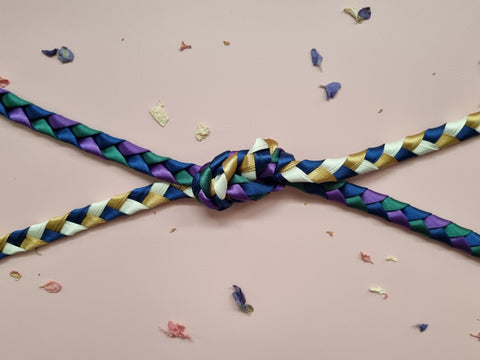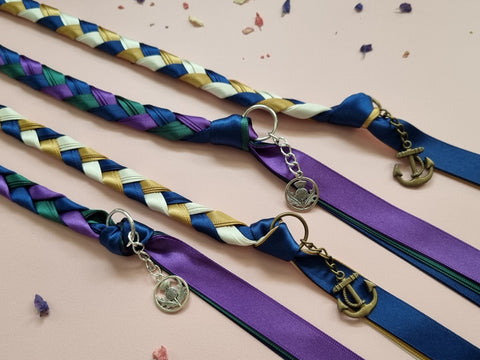About Handfasting Ceremonies
What is a Handfasting Ceremony?
The phrases ‘tying the knot’, and ‘giving one’s hand in marriage’ are synonymous with getting married, and with good reason! They originate from an ancient Celtic tradition going back as far as 7000 B.C., called the Handfasting Ceremony, where couples would give one hand to be bound with their future spouse’s, by braided cord or ribbon, marking their engagement.
This symbolic gesture has been incorporated into wedding ceremonies and practised by many different cultures all over the world, religious and non-religious, signifying the binding of two lives. It is a simple yet moving symbol of two people joining together in marriage. Since handfasting cords can be personalised with different colours and charms, the Handfasting ceremony is a wonderful combination of tradition and modernism.
How does the Handfasting Ceremony work?
Handfasting ceremonies can be incorporated into Weddings, Affirmation of Vows and Vow Renewals. It works best before, during, or after vows are taken.
Your celebrant/officiant will wrap the cords around yours and your partner’s joined hands and say some meaningful words about what the symbolic gesture represents. Then you can incorporate your vows and exchange of rings if you wish. You and your partner will then tie the knot - a great picture moment!
The cords can be tied around a bouquet or laid on the top table for the remainder of the day. They make a wonderful keepsake to remember your wedding day by and can even be framed in a shadow box.
How many cords do we need?
The ceremony can be done with as few or as many cords as you like, though they are most commonly done with 2 cords, with the idea that one cord represents you and the other represents your partner, and you are tying your lives together.
However, handfasting ceremonies can use 3 or even up to 6 cords - since multiple cords can be wrapped by close friends or family members, with each cord representing their love and support for you, it is a great way to involve them in your big day and works especially well for blended families.
Our standard cord length is 1.5m, which is a great fit across the various tying methods, though different lengths can be made on request by email.
How do we tie the knot?
There are a variety of ways to tie handfasting cords. Your celebrant/officiant probably has one or two go-to methods, but if you have a preference, make sure you discuss this with them so that they can prepare accordingly.
Here are a few of my personal favourites in which the celebrant/officiant does the trickier part of wrapping the cords and you get to tie the knot yourselves:
The Kiss/Saltire
A minimum of two cords are required (or an even number of cords).
You and your partner face each other, with one pair of wrists resting on the other’s forearms. One cord is laid over your wrists, and the second cord is laid over your partner’s.
You each take hold of the cord ends with both hands and pull away to tie the knot in such a way that the cords form a ‘kiss’ or ‘saltire’ shape. This looks lovely in pictures and can be a wee nod to Scottish heritage.


The Infinity Knot
Any number of cords can be used for this method.
You and your partner join one hand, leaving the other hand free (which you can use to exchange rings and vows with if you wish!).
The cords are wrapped around your joined hands by your celebrant/officiant, then you slip your hands away and use your other hand to tie the knot in such a way that you are left with an infinity knot, as the name suggests. A lovely way to symbolise ever-lasting love between you and your partner. And a wee nod to the nautical! The ‘kiss’ or ‘saltire’ shape can also be achieved by separating the cords with both hands – talk about versatility!


The Loop
Any number of cords can be used for this method.
You and your partner hold onto each other’s forearm, leaving one hand free.
Each cord is wrapped along your joined arms in loops, then you each take a hold of the cord ends and slip your hands out of said loops, tying the knot. The loops look lovely in pictures. Again, the ‘kiss’ or ‘saltire’ shape can be achieved by separating the ends of the cords, with the knot in the centre. Fabulous!


Can we personalise our Handfasting Cords?
Absolutely! Have a look at our curated collection of handfasting cords – you can swap the charms for others or choose to have no charms at all.
You can also order custom made cords, picking from a wide range of colours and charms. You can select matching cords or choose to have a different style for each cord.
If you would like a particular charm that is not displayed, please email us, and we will try to source it for you. If you have any questions at all, please do not hesitate to contact us at info@intertwinedhandfastingcords.com!
